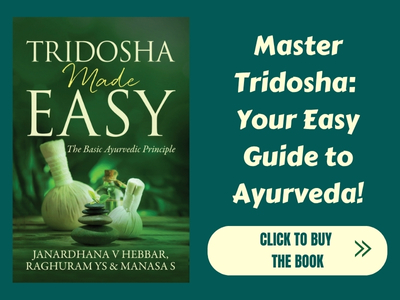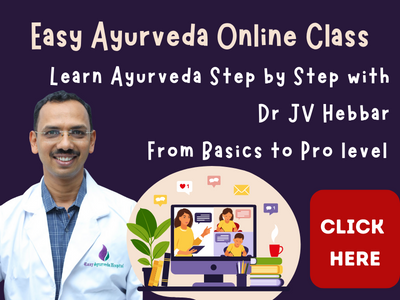Sushruta Samhita Sutrasthana Chapter 40 Dravya Rasaguna Virya Vipaka Vijnaniya Adhyaya (Knowledge of Substances and Their Qualities)
The 40th chapter of Sutrasthana of Sushruta Samhita is named as Rasaguna Virya Vipaka Vijnaniya Adhyaya. This chapter deals with Knowledge of Substances and Their Qualities.
अथातो द्रव्यरसगुनवीर्यविपाकविपाकविज्ञानीयमध्यायं व्यख्यास्यमः॥
यथेवाच भगवान् धन्वन्तरिः ॥२॥
We will now expound the chapter by name Dravya rasa guna Virya Vipaka Vijnaniya- Knowledge of Substances, their tastes, qualities, potencies and tastes after- digestion; as revealed by the venerable Dhanvantari.
Table of Contents
Dravyan Pradhanam: Substances are the most important
केचिदाचार्या ब्रुवते-द्रव्यं प्रधानंकस्मात् ? व्यवस्थितत्वार्, इह खलुद्रव्यं व्यवस्त्तं न रसदयः, यथा- आमे फले ये रसादयस्ते पक्वे न सन्ति; नित्यत्वाच्च, नित्यम् हि द्रव्यमनित्या गुणाः, यथा कल्कादिप्रविभागः, स एव सम्पन्नरसगन्धो व्यापन्नरसगन्धो व भवति;
स्वजात्यवस्थानाच्च, यथा हि पार्थिवं द्रव्यमन्यभावं न गच्छत्येवं शेषाणि; पञ्चेन्द्रियग्रहणच्च, पञ्चभिरिन्द्रयैर्गृह्यते द्रव्यं न्न रसादयः; आश्रयत्वाच्च, द्रव्यमाश्रिता रसादयः; आरम्भ सामर्थ्याच्च, द्रव्याश्रित आरम्भः, यथा-“विदारिगन्धादिमाहृत्य संक्षुद्य विपचेत् ’इत्येवमादिषु न रसादिष्वारम्भः; शास्त्रप्रामाण्याच्च, शास्त्रे हि द्रव्यं प्रधानमुपदेशे योगानां, यथा- “मातुलुङ्गाग्रिमन्थौ च’ इत्यादौ न रसादय उपदिश्यन्ते; क्रमापेक्षितत्वाच्च रसादीनां , रसादयो हि द्रव्यक्रममपेक्षन्ते, यथा- तरुणे तरुणाः संपूर्णे संपूर्णो इति; एकदेशासाध्यत्वाच्च, द्रव्याणामेकदेशेनापि व्याधयः साध्यन्ते, यथामहाव्रुक्षक्षीरेणेति; तस्माद्रव्यं प्रधानं न रसादयः कस्मात्? निरवयवत्वात् । द्रव्यलक्षणं तु ’क्रियागुणवत्समवायिकारणम्” इति॥३॥
According to some authorities dravya – substance in general, drug or herb in this context is the most important one (among dravya, guna, virya etc). Why is it? The reasons are as below mentioned –
1. Vyavasthitatva – this is a property of being constant. According to Ayurveda, Dravya i.e. substance is constant. On the other hand, the tastes etc qualities are not constant. Example – the tastes etc present in the unripe fruit and ripe fruit are totally different. This shows that tastes etc qualities keep changing, but the fruit, which is a dravya, is the same i.e. constant. Vyavasthitatva is constancy which is present only in dravya and not in tastes or qualities
2. Nityatva (permanency) – Nityatva means being permanent. Dravya is permanent whereas guna i.e. qualities are not permanent. Example, qualities of formulations like powder, paste, juice, infusion, decoction etc are not permanent. They will either be good or bad due to the influence of different factors like time, method of preparing etc.
3. Svajatyavasthana – Svajathi Avasthana means stability in its own category. Example, a dravya which is parthiva i.e. predominantly made up of earthy elements and is solid in nature will not change into a different category. It will be stable in its own category i.e. being parthiva. Similarly, the remaining dravyas i.e. apya – liquid substances, agneya dravya – fiery substances, vayaviya dravya – airy substances and nabhasa or akasiya dravyas – ethereal substances also remain stable in their own categories and do not change into any category other than its own, by any means.
4. Panchendriya graham – Dravyas can be perceived by all the five sense organs. Apart from dravya, no other entities i.e. taste, qualities etc are perceivable by all five senses.
5. Asrayatva (seat / asylum) – Only Dravya is a seat or abode of taste etc qualities. They reside in the dravya. The other way is not possible.
6. Arambha Samarthya – It is the ability of the dravya to commence an action – treatment in his context. The action of a substance / drug / medicine – totally depends on the dravya itself. As in the statement – ‘Vidarigandhadi should be collected, pounded and boiled in water and such others (statements)”, it is clear that collection, pounding, boiling etc works can be initiated and done only with the dravya but they cannot be accomplished in its qualities like taste etc.
7. Sastra Pramana – Dravya is the most important one as testified by the scriptures. The authoritative texts and treatises of Ayurveda have advocated that it is the dravya which is the most important one and not the tastes, qualities etc. In the description of any formulation it is only the dravyas which have been mentioned but not its taste etc. Example – In the formulation ‘Matulungadi Yoga’ the drugs included in it i.e. Matulunga, Agnimantha etc are mentioned and they are the names of the substances (dravya). On the other hand their tastes etc qualities have not been mentioned in these contexts.
8. Kramapeksitatva:- The tastes etc. desire and depend on the order of succession with respect to time. Example – the tastes etc are also young i.e. mild or weak in the young substances i.e. dravyas that are unripe or immature. On the other hand, in the mature and fully grown substances – ripe dravyas, the tastes etc. are also strong and well manifest.
9. Ekadesa sadhyatva – (efficacious even by parts) – diseases can be treated even by any one part / portion of the substances / drugs). For example the milky sap of Mahavrksha (snuhi) is used for curing many diseases like abdominal tumors, colic, distension (flatulence) of abdomen, enlargement of liver etc. The same is not possible by parts of taste etc.
Due to the above said reasons we can tell that the dravya is the most important one and not the tastes etc. (qualities). This is because, tastes etc. have no parts. The definition of Dravya goes like – ‘Dravya is that which is an abode of tastes, qualities, action as its inherent / inseparable cause (relationship)’. Karma – action and Gunas – qualities are considered as Avayava – component or part of the dravya.
Rasa pradhanam: Taste is the most important
नेत्याहुरन्ये, रसास्तु प्रधानं कस्मात् ? आगमान्,आगमो हि शास्त्रमुच्यते ; शास्त्रेहि रसा अधिक्रुताः, यथ- रसायत्त आहार इति, तस्मिंस्तु प्राणाः; उपदेशाच्च, उपदिश्यन्ते हिरसाः ; यथा- मधुराम्ललवणा वातं शमयन्ति; अनुमानाच्च, रसेन, ह्यनुमीयते द्रव्यम्, यथामधुरमिति; ऋ षिवचनाच्च, ऋषिवचनं वेदो यथा- किम्चिदिज्यार्थं मधुरमाहरेदिति, तस्माद्रसाः प्रधानं; रसेषु गुणसंज्ञा। रसकक्षणमन्यत्रोपदेक्ष्यामः ॥४॥
According to some authorities, dravya is not the most important one, it is the rasa i.e. tastes of substances only that is the most important one. Why is it so? It is because of the below mentioned reasons –
1. Agama – Agama means science or treatises. Even science deals with tastes only. Example – a statement tells ‘food depends on rasa – tastes and life depend on food’.
2. Upadesa – Upadesa means instructions. It is only the tastes that are implied in statements such as – ‘sweet, sour and salt tastes mitigate vata’.
3. Anumana – Anumana means inference. The dravya is inferred by its taste only. Example, saying ‘this substance is sweet, this substance is bitter’ etc.
4. Rsi Vacana – Rsi Vacana means words or statements of sages, which are the Vedas themselves. Example, a Vedic statement says – ‘bring some sweets for conducting the sacrifice’.
Because of the above said reasons, we can tell that Rasa – taste is the most important one. It is through the rasa, the gunas i.e. qualities of the dravyas are understood. The properties of rasas will be described later, elsewhere.
Viryam Pradhanam: Potency is the most important
नेत्याहुरन्ये, वीर्यं प्रधानमिति। कस्मात्? तद्वशेनौषधकर्मनिष्पत्तेः । ईहौषधकर्माण्यूर्ध्वाधोभागोभयभागसंशोधनसंशमनसंग्राहिकाग्रिदीपनपीडनलेखनबृंहणरसायनवाजीकरणश्वयथुकरविलयनदहनदारणमादानप्राणघ्नविषप्रशमनादिनि वीर्यप्राधान्याद्भवन्ति।तच्च वीर्यं द्विविधमुष्णं शीतं च, अग्रीषोमियत्वाज्जगतः। केचिदष्टविधमाहु:- शीतमुष्णं शीतमुष्णं स्निग्धं सूक्षं विशदं पिच्छिलं मृदुं तीक्ष्णं चेति। एतानि विर्याणि स्वबलगुणोत्कर्षाद्रसमभिभूयात्मकर्म कुर्वन्ति । यथा तावन्महत्पञ्चमूलं कषायं तिक्तानुरसं वातं शमयति उष्णवीर्यत्वात्; तथा कुकत्थः कषायः, कटुकः पलाण्डुः स्नेहभावाच्च; मदुरश्चेक्षुरसो वातं वर्धयति शीतविर्यत्वात् ः कटुका पिप्पली पित्तं शमयति मृदुशितवीर्यत्वात्, अम्लमामलकं लवणं सैन्धवं च; तिक्ता काकमाची पित्तं वर्धयति, उष्णवीर्यत्वात् ; मधुरा मत्स्याश्च, कटुकं मूलकं श्लेष्माणं वर्धयति, स्निग्धवीर्यत्वात्; अम्लं कपित्थं श्लेश्मानं शमयति, रुक्षवीर्यत्वात्, मधुरं क्षौद्रं च; तदेतन्निदर्शनमात्रमुक्तम् ॥५॥
According to some other authorities, it is not so, i.e., rasa (or dravya) is not important but the Virya – potency of the herb is the most important. It is only because of virya, the actions of the dravyas are possible. This means to say that virya is responsible for the actions of the substances. According to Ayurveda, actions such as vamana i.e. purification of the body by upper route i.e. emesis, by lower route i.e. purgation and by both routes, and other actions like shodana – cleansing, shamana – mitigation, sangrahi – withholding, agni dipana – increasing digestive power, pidana – squeezing, lekhana – scarifying, brimhana – stoutening, rasayana – rejuvenation, vajikarana – vilification / aphrodisiac, shvayathu kara – producing swelling, vilayana – dissolving, dahana – burning or cauterization, darana – bursting of swelling, madana – causing intoxication, pranagna – causing loss of life, vishaprashamana – detoxification of poisons etc. are possible only because of predominance of virya – potency.
Virya is of two types – Usna i.e. hot potency and Shita i.e. cold potency. This categorization has been done because the world is predominant in qualities of fire and water. According to some other authorities, virya is of eight kinds i.e. –
– sita (cold),
– usna (hot),
– snigdha (unctuous),
– ruksa (dry),
– visada (viscid),
– picchila (slimy),
– mrdu (soft), and
– tiksna (sharp, penetrating)
These viryas become powerful in their own qualities and perform their actions by nullifying the rasa i.e. tastes of the substance / drug. Examples are as below mentioned –
– Maha Pancamula is predominant in kasaya rasa i.e. astringent taste as its main rasa and tikta rasa i.e. bitter taste as its anurasa i.e. secondary taste, both of which are vata increasing tastes. But it still mitigates vata because of its usna virya i.e. hot potency. Same is the case with Kulattha – horse gram which is astringent in taste.
– Palandu – onion is katu – pungent (vata increasing taste) but mitigates vata because of its snigdha virya i.e. unctuous potency.
– Ikshu Rasa – sugarcane juice is Madhura – sweet in taste (vata pacifying taste), but still increases vata because of its shita virya – cold potency.
– Pippali – Piper longum is katu – pungent in taste (pitta increasing taste) but still mitigates pitta because of its mrdu virya – soft potency and shita virya – cold potencies.
– Similarly, Amalaka – Emblica officinalis though sour (pitta increasing taste) and Saidhava – rock salt though salty (pitta increasing) in taste, still mitigate pitta;
– Kakamaci is bitter (pitta pacifying) in taste, but it still increases pitta because of its usna virya i.e. hot potency.
– Similarly, Matsya (fish) though sweet in taste (pitta pacifying taste), increases pitta
– Mulaka – radish is katu – pungent in taste (kapha pacifying taste) but it still increases kapha due to its snigdha virya – unctuous potency.
– Kapitha is sour (kapha increasing taste) in taste but it still mitigates kapha because of its ruksha virya i.e. dry potency.
– Madhu i.e. honey, is sweet in taste (kapha increasing taste) mitigates kapha due to its ruksha virya – dry potency,
These are only the examples to show how virya works and why it is important (but there are many more).
Some verses here:-
ये रसा वातशमता भवन्ति यदि तेषु वै।
रौक्ष्यलाघवशैत्यानि न ते हन्युः समीरणम् ॥६॥
ये रसाः पित्तशमना भवन्ति यदि तेषु वै।
तै क्ष्ण्यौष्णयलघुताश्चैव न ते तत्कर्मकारिणः ॥७॥
ये रसाः श्लेष्मशमना भवन्ति यदि तेषु वै ।
स्नेहगौरवशैत्यानि न तेत्कर्मकारिणः ॥८॥
Vata mitigating tastes (Madhura, amla, lavana – which are supposed to mitigate vata) will not mitigate vata if they possess ruksha – dry, laghu – light (soft) and shita (cold) potencies.
Pitta mitigating tastes (Madhura, tikta, Kashaya – which are supposed to mitigate pitta), will not mitigate pitta if they possess Tikshna – sharp, ushna – hot and laghu – light (soft) viryas.
Kapha mitigating tastes (Katu, Tikta, Kashaya – which are supposed to mitigate kapha), will not mitigate kapha when they possess snigdha – unctuous, guru – heavy and shita – cold potencies.
तस्माद्वीर्यं प्रधानमिति ॥९॥
Hence, due to the above said examples, we can tell that Virya (potency) is the most important.
Vipaka Pradhanam: Taste – after- digestion is most important
तत्तुनेत्याहुरन्ये, विपाकः प्रधानमिति । कस्मात् । सम्यङ्मिथ्याविपक्वत्वात् ः इह सर्वद्रव्याण्यभ्वहृतानि सम्यङ्मिथ्याविपक्वानि गुणं दोषं वा जनयन्ति। तत्राहुरन्ये- प्रति रसं पाक इति।
केचित्त्रिविधमिच्छन्ति- मधुरमलं कटुकं चेति। तत्तु न सम्यक, भूतगुणादागाच्चाअन्योऽल्मो विपाको नास्ति, पित्तं हि विदग्धमम्लतामुपैत्याग्रेयत्वात्; यद्येवंलवणोऽम्लप्यन्यः पाको भविष्यति, श्लेष्पा हि विदग्धो लवणतामुपैतीति। मधुरो मधुरस्याम्लोऽम्लस्यैवं सर्वेषामिपि केचिदाहुः; दृष्टान्तं चोपदिशन्ति, -यथा तावत् क्षीरमुखागतं पच्यमानं मधुरमेव स्यात्तथा शालियवमुद्रादयः प्रकीर्णाः स्वभावमुत्तरकालेऽपि न परित्यजन्ति तद्वदिति। केचिद्वदन्ति- अबलवन्तो बलवतां वशमायान्तीति। एवमनवस्थितिः, तस्मादसिद्धान्त एषः । आगमे हि द्विविध एव पाको मधुरः कटुकश्च। तयोर्मधुराख्यो गुरुः, कटुकाख्यो लघुरिति।
तत्र पृथिव्यप्तेजोवाय्वाकाशानां द्वैविध्यं भवति गुणसाधर्म्यादुरुता लघुता च; पृथिव्यापश्च गुर्व्यः, शोषाणि लघूनि; तस्माद्विविध एव पाक इति॥१०॥
Some others say, ‘It is not so, Vipaka i.e. taste of the drug after its digestion is most important’. Why is it so? This happens due to proper and improper digestion. All the dravyas i.e. substances which one consumes would produce good or bad effect only after undergoing proper or improper digestion.
According to the opinion of some authorities, each rasa undergoes digestion and remains as such in vipaka also. This means to say that since there are six tastes, there are six kinds of vipaka also. Some others say that Vipaka is of three kinds only i.e. Madhura Vipaka – sweet taste after digestion, Amla Vipaka – sweet taste after digestion and Katu Vipaka – pungent taste after digestion. But these opinions are incorrect.
There cannot be a separate Amla Vipaka, because from the properties of five primary elements or from the agama i.e. scriptures / texts of Ayurveda (not mentioned in the scriptures), the presence of a separate amla vipaka cannot be justified.
Pitta itself in its vidagdha Avastha i.e. improperly cooked / processed state becomes sour in taste because of its hot quality. Similarly, there is no separate lavana vipaka as well. Kapha, in its vidagdha state i.e. when improperly cooked, becomes salty in taste.
According to some others, Madhura rasa – sweet taste becomes Madhura Vipaka itself – sweet taste after its digestion. Similarly other tastes too remain as such i.e. undergo the same vipaka as of their tastes. They give these examples to understand this context – milk boiled in a vessel remains sweet only (even after cooking / boiling) and Sali – rice, Yava – barley, Mudga – green gram etc. which are sown do not leave off their natural qualities even later on.
According to the opinion of some others, weak tastes are overpowered by the strong tastes and thus there is uncertainty. Hence, this hypothesis is weak and unsustainable.
Even according to scriptures – vipaka has been declared to be of only two kinds – Madhura – sweet and Katuka – pungent. Among these vipakas – Madhura vipaka is guru – heavy and Katu vipaka is laghu – light. By the combination of identical properties, the five elements i.e. Prthvi – earth, Ap – water, Tejas – fire, Vayu – air and Akasa – ether form two groups i.e. guru – heavy and laghu – light. Prthvi and ap are guru (heavy). The remaining i.e. Tejas, Vayu and Akasa are laghu (light). Therefore, Vipaka is only of two kinds.
Identifying the manifested Vipaka
भवन्ति चात्र:-
द्रव्येश्गुपच्यमानेषु येष्वम्बुपृथिवीगुणाः।
निर्वर्तन्तेऽधिकास्तत्र पाको मधुर उच्यते ॥११॥
तेजोऽनिलाकाशगुणाः पच्यमानेषु येषु तु।
निर्वर्तन्तेऽधिकास्तत्र पाकः कटुक उच्यते॥१२॥
Some verses here:-
During the digestion of dravyas, when the qualities of prthvi – earth and ambu – water are produced more in them, the Vipaka which would ensue is called as Madhura i.e. sweet taste after digestion.
If during the digestion of substances, the qualities of Tejas (agni) – fire, Vayu – air and Akasa – ether – are produced greatly in them, the ensuing Vipaka will be called Katu i.e. pungent taste after digestion.
Combination of dravya etc. factors is important!
पृथक्त्वदर्शिनामेष वादिनां वादसंग्रहः ।
चतुर्णामपि सामग्र्यमिच्छन्त्य विपश्चितः ॥१३॥
Scholars consider the combination of all the four factors i.e. dravya – substance, rasa – taste, virya – potency and vipaka – taste after digestion are important in spite of these collection of postulates of various authorities who argue substantiating the importance of each one of these four factors (detailed herein, in this chapter).
ततद्रव्यमात्मना किंचित्किंचिद्वीर्येणसेवितम् ।
किंचिद्रसविपाकाभ्यां दोषं हन्ति करोति वा॥१४॥
Some dravyas – substances either cause mitigation or aggravation of doshas all by themselves (dravya). Some others mitigate or aggravate doshas by means of their virya – potency, some others by virtue of their rasa – taste and some more do this by their vipaka – taste after digestion.
Why is dravya the most important one?
पाको नास्ति विना विर्याद्वीर्यं नास्ति विना रसात्।
रसो नास्ति विना द्रव्यातद्रव्यं श्रेष्ठतमं स्मृतम् ॥१५॥
There can be no Vipaka – taste after digestion without Virya – potency.
Similarly, there will be no Virya without Rasa – taste.
There will be no Rasa without Dravya – substance.
Therefore, Dravya – substance is the most important of all.
जन्म तु द्रव्यरसयोरन्योन्यापेक्षिकं स्मृतम् ।
अन्योन्यापेक्षिकं जन्म यथा स्याद्देहदेहिनोः ॥१६॥
वीर्यसंज्ञा गुणा येऽष्टौ तेऽपि द्रव्याश्रयाः स्मृताः ।
रसेषु न भवन्त्येते निर्गुणास्तु गुणाः स्म्तुताः ।१७॥
द्रव्ये द्रव्याणि यसाद्धि पिपच्यते न षड्र्साः ।
श्रेष्टं द्रव्यमतो ज्ञेयं शेषा भावास्तदाश्रय्’
Just like the body and the soul are interdependent right from the birth of an individual, Dravya – substance and Rasa – taste is also said to be interdependent right from their birth i.e. origin.
Eight qualities are mentioned as Virya – potencies. Even these viryas also reside in the dravya – substance itself.
These viryas are not present in the Rasas – tastes. This is because the qualities by themselves cannot accommodate other qualities to reside within them.
It is not the six tastes that undergo digestion in the body but it is the dravya (consisting of them) which undergoes digestion.
Therefore, the dravya alone should be understood as the most important one. All the other factors i.e. rasa, virya and vipaka should be considered and understood as sheltered in the dravya.
Amimamsyam Bhesajam: Properties of drugs not to be discussed
अमीमांस्यान्यचिन्त्यानि प्रसिद्धानि स्वभावतः ।
आगमेनोपयोज्यानि भेषजानि विचक्षणैः ॥१९॥
प्रत्यक्षमक्षणफलाः प्रसिद्धाश्च स्वभावतः ।
नौषधीर्हेतुभिर्विद्वान् परीक्षेत कदाचन ॥२०॥
सहस्त्रेणापि हेतूनां नाम्बष्ठादिर्विरेचयेत् ।
तस्मात्तिष्ठेत्तु मतिमानागमे न तु हेतुषु॥११॥
Intelligent persons (physicians) should not discuss or think about the properties of drugs which are already popular and well known by their very nature (by birth itself). He should bring them into practice as advocated in the scriptures (texts of Ayurveda).
The drugs whose properties (effects) and results are perceivable directly and those which are popular and well known by their very nature (naturally known since a long time) should never be re-examined by an intelligent physician. Even with a thousand reasons, causes, discussions or arguments the purgation effect of Ambasthadi Gana groups of medicines (herbs, drugs) cannot be proved or justified (because they do not produce purgation and this is popularly known through ages). Therefore the wise person (physician) should believe / trust (adhere to) the scriptures and not on other causes / reasons.
इति श्रीसुश्रुतसंहितायां सूत्रस्थाने द्रव्यगुणरसवीर्यविपाकविज्ञानीयो नाम चत्वारिंशत्तमोऽध्यायः ॥४०॥
Thus ends the fortieth chapter by name Dravya- rasa- Guna Virya- Vipaka Vijnaniya is Sutra sthana of Susruta Samhita.









